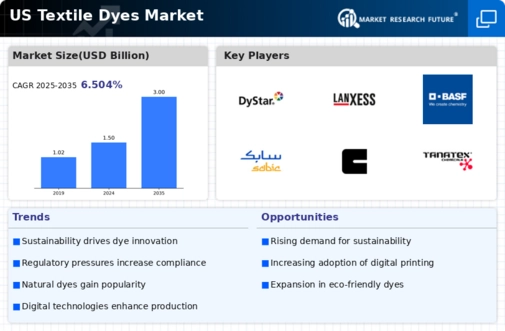The textile dyes market is characterized by a dynamic competitive landscape, driven by innovation, sustainability, and technological advancements. Key players such as Huntsman Corporation (US), BASF Corporation (US), and Clariant Corporation (US) are at the forefront, each adopting distinct strategies to enhance their market positioning. Huntsman Corporation (US) focuses on developing eco-friendly dye solutions, aligning with the growing demand for sustainable products. Meanwhile, BASF Corporation (US) emphasizes digital transformation, leveraging data analytics to optimize production processes and improve customer engagement. Clariant Corporation (US) is actively pursuing strategic partnerships to expand its product portfolio and enhance its market reach, thereby contributing to a more competitive environment.
The business tactics employed by these companies include localizing manufacturing and optimizing supply chains to enhance efficiency and responsiveness to market demands. The market structure appears moderately fragmented, with several players competing for market share. However, the collective influence of major companies shapes the competitive dynamics, as they strive to differentiate themselves through innovation and sustainability initiatives.
In November 2025, Huntsman Corporation (US) announced the launch of a new line of biodegradable dyes, which is expected to significantly reduce environmental impact. This strategic move not only aligns with global sustainability trends but also positions Huntsman as a leader in eco-friendly dye solutions, potentially attracting environmentally conscious consumers and brands.
In October 2025, BASF Corporation (US) unveiled a new digital platform aimed at enhancing customer interaction and streamlining order processes. This initiative is likely to improve customer satisfaction and operational efficiency, reflecting BASF's commitment to integrating technology into its business model, which may provide a competitive edge in a rapidly evolving market.
In September 2025, Clariant Corporation (US) entered into a strategic partnership with a leading textile manufacturer to co-develop innovative dyeing technologies. This collaboration is anticipated to enhance Clariant's product offerings and strengthen its market position, as it allows for the integration of cutting-edge technologies into traditional dyeing processes, thereby improving efficiency and sustainability.
As of December 2025, the textile dyes market is witnessing trends such as digitalization, sustainability, and the integration of AI technologies. Strategic alliances among key players are shaping the competitive landscape, fostering innovation and collaboration. The shift from price-based competition to a focus on technological advancements and supply chain reliability is becoming increasingly evident. Moving forward, companies that prioritize innovation and sustainability are likely to gain a competitive advantage, as the market evolves towards more responsible and efficient practices.


















Leave a Comment